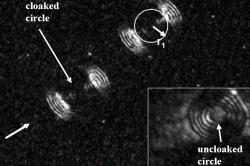Reprint of Original Article
Source:
http://technology.newscientist.com/article.ns?id=dn12722&feedId=online-news_rss20

The world's first true invisibility cloak a device able to hide an object in the visible spectrum has been created by physicists in the US. But don't expect it to compete with stage magic tricks. So far it only works in two dimensions and on a tiny scale.
The new cloak, which is just 10 micrometres in diameter, guides rays of light around an object inside and releases them on the other side. The light waves appear to have moved in a straight line, so the cloak and any object inside appear invisible.
The cloak was built by a team led by Igor Smolyaninov at the University of Maryland, and borrows some ideas from the first theoretical design for an invisibility cloak, published by Vladimir Shalaev from Purdue University, West Lafayette, Indiana, US, earlier this year.
Their breakthrough comes just a year after US and British physicists created an invisibility cloak that worked in the microwave region of the electromagnetic spectrum. At that time, a visible light cloak was thought to be years away because of the much shorter wavelengths produced in the visible spectrum.
"At optical frequencies, [wavelengths] get very tiny, and the range of properties available from materials is limited," says John Pendry, a physicist at Imperial College London, and a member of the team that produced the microwave invisibility cloak.
To get around this problem, Smolyaninov's team confine light to two dimensions. "The new cloak doesn't control the light you can see directly," explains Ulf Leonhardt, a physicist at the University of St Andrews, UK. "It's not the invisibility most people would imagine."
The Maryland researchers inject polarised cyan light into a gold surface using a tiny optical fibre with a fine tip. The light waves become converted into surface plasmons waves rippling through the electrons of the gold surface, effectively in two dimensions.
Three-dimensional invisibility cloaks would have to control light waves both magnetically and electronically to steer them around the hidden object. But two-dimensional surface plasmons are easier to direct, explains Pendry. "You can operate on either the electric or magnetic channel alone," he says.
Smolyaninov's cloak consists of a two-dimensional pattern of concentric gold rings coated in a plastic called polymethyl methacrylate. The plastic and the gold each have different refractive properties, and bend plasmons in different directions. The whole arrangement lies flat on the gold surface mentioned above.
By varying the mix of metal and plastic in different areas of the cloak, Smolyaninov's team can control plasmons with enough precision to guide them around the cloak. A simple visual analogy might be river water flowing around a rock.
It is unlikely that the cloak is perfectly invisible, though, says Pendry. The Maryland team do not report whether plasmons can reflect off the surface of their cloak. If they can, an observer could still detect its presence, just as reflected light allows us to see a sheet of glass.
Smolyaninov's cloak is unlikely to be developed into a version that works in three dimensions. But Leonhardt says it could be useful in the near future. "It could be used on computer chips," he says. "You could use surface plasmons to communicate between different areas of a microchip."
Pendry agrees, saying they might replace fibre optics as a way to carry signals: "Light on a chip might seem more prosaic than an invisibility cloak, but in the end it might be more practically important."
The University of Maryland team posted a paper describing the new cloak on the arXiv preprint server (arxiv.org/abs/0709.2862).
Reprint Courtesy of:
Disclaimer the New Scientist does not endorse the Grant Chronicles or agree or disagree with its content
Return